

10/2005
Charlotte leads the way in creating integrated learning environment
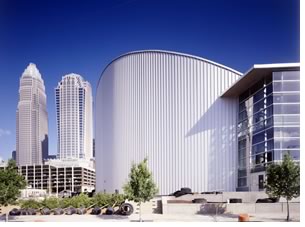 A
new, one-of-a-kind facility is simultaneously turning heads and reinventing
children’s educational and entertainment spaces in Charlotte. ImaginOn:
The Joe & Joan Martin Center by Holzman Moss Architecture, with Gantt
Huberman Architects, was designed to “nurture young people at every
stage of development.” With its sloping roof, playful geometrical
shapes, and focus on storytelling, ImaginOn is both compelling and engaging
for visitors of all ages. The brainchild of Bob Cannon, former executive
director of the Public Library of Charlotte and Mecklenburg County (PLCMC),
and Bruce LaRowe, executive director of the Children’s Theatre
of Charlotte (CTC), ImaginOn integrates the two entities into a new facility
type with an original approach to education, learning, and the arts.
A
new, one-of-a-kind facility is simultaneously turning heads and reinventing
children’s educational and entertainment spaces in Charlotte. ImaginOn:
The Joe & Joan Martin Center by Holzman Moss Architecture, with Gantt
Huberman Architects, was designed to “nurture young people at every
stage of development.” With its sloping roof, playful geometrical
shapes, and focus on storytelling, ImaginOn is both compelling and engaging
for visitors of all ages. The brainchild of Bob Cannon, former executive
director of the Public Library of Charlotte and Mecklenburg County (PLCMC),
and Bruce LaRowe, executive director of the Children’s Theatre
of Charlotte (CTC), ImaginOn integrates the two entities into a new facility
type with an original approach to education, learning, and the arts.
Both CTC and PLCMC individually enjoyed tremendous community success prior to their integration. In fact, the organizations and their programs were so popular that they were quickly running out of space to accommodate demand. Cannon and LaRowe realized that, in addition to sharing a need for more space, their organizations also shared a mission: to bring stories to life for children. ImaginOn was designed to support that mission and the individual programmatic needs of both organizations.
 The building itself was not just conceived as an activity center, it
was designed to captivate the minds and imaginations of children and
teens. According to Malcolm Holzman, FAIA, partner, Holzman Moss, “The
building engages visitors of all ages in a variety of programs and activities
as well as in the structure itself...The vigorous interaction among design
elements is as much a part of a visit to ImaginOn as attending a performance.
It is an aspect of the story that can be taken away and considered in
relationship to other building environments.”
The building itself was not just conceived as an activity center, it
was designed to captivate the minds and imaginations of children and
teens. According to Malcolm Holzman, FAIA, partner, Holzman Moss, “The
building engages visitors of all ages in a variety of programs and activities
as well as in the structure itself...The vigorous interaction among design
elements is as much a part of a visit to ImaginOn as attending a performance.
It is an aspect of the story that can be taken away and considered in
relationship to other building environments.”
According to Holzman there are three primary ways ImaginOn engages visitors: culturally, intellectually, and sensually. Because of its central downtown location, ImaginOn becomes a critical element in Charlotte’s growing arts district. Intellectually, the building is designed to stimulate curiosity and engage the mind. On a sensual level, the bold shapes, colors, and textures enhance the visitor’s visual and tactile experience. The result is a fun and functional facility with, much like a story, many elements that are open to interpretation.
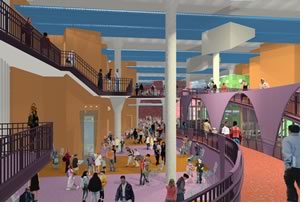 Activities support creative expression
Activities support creative expression
The interactive activities at ImaginOn, designed to spark and strengthen
children’s creativity, were created by experiential design firm
ESI Design. ESI Principal Designer Ed Schlossberg says, “ImaginOn’s
interactive experiences invite visitors to participate in the creative
process. Through engagement and collaboration, children will gain an
understanding of how an idea evolves into a story, often leading to
the creation of a book, a play, or an illustration. After spending
the day at ImaginOn, children will be motivated to express their imaginations
in new and exciting ways.” Highlights of the program include:
- ImaginOn Central: The facility’s welcome center and hub where visitors learn about activities, events, and a daily scavenger hunt.
- Team machines: Children work collaboratively on activities such as creating theatrical scenes or drawings.
- Tale spinners: Children create stories and drawings, add them to the Story Jar, and read stories by other kids.
- Story Jar: A large, colorful mobile that is the physical manifestation of the stories and drawings contributed by visitors.
- WeeTeeVees: Televisions that are hidden throughout the facility which provide anticipation of discovery and present visitor information and scavenger hunt clues.
- Spy-noculars: Rail-mounted binoculars that are placed throughout the building to encourage exploration of the spaces within.
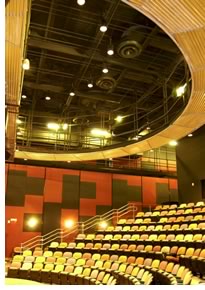 “Exciting and moving theatre”
“Exciting and moving theatre”
ImaginOn boasts two performance spaces that offer exceptional experiences
for audience and cast alike. The McColl Family Theatre is the larger
of the spaces with 410 seats on the mezzanine and 160 seats in the
balcony. It offers a 38-foot-wide proscenium opening; a single-purchase
line set system which allows for the use of 36 different flying elements
in a production; a 54-foot fly loft, enabling scene designers to create
flying elements up to 27-feet high; a 20-foot by 32-foot trappable
section of stage floor; a lighting system that contains 336 individual
dimmer elements; and an orchestra pit that holds 20 musicians. In addition,
carefully planned sightlines and seat elevations offer a tremendous
view from every seat in the house.
The intimate Wachovia playhouse contains 250 seats and is home to the Tarradiddle Players, CTC’s resident touring company. It will also host student performances and other programs. Multihued stadium seating, walls, and carpeting creates a fun yet cozy atmosphere for theatergoers. The playhouse features a proscenium stage that can convert to a modified thrust, walls that can be removed to create a black box theatre, a 16-foot-wide thrust apron that brings the action directly to the audience, and state-of-the-art lighting equipment with a 250-channel control board. The two theatre spaces allow CTC to stage productions that range from a single-performer show to a large-scale production complete with a live orchestra.
CTC Artistic Director Alan Poindexter notes that this is the first time that the production company has had a performance space that was designed for theatrical productions. Prior “homes” included a converted VFW post and a former church. “ImaginOn represents the first time in Children’s Theatre’s 58-year history that the organization will perform on stages specifically designed for the theatre,” says Poindexter. “From a production perspective, having adequate fly and wing space in both theatres will enhance our ability to create exciting and moving theatre.”
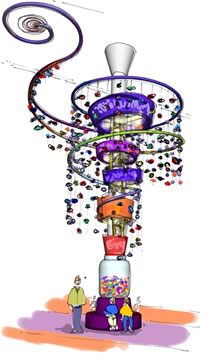 Library programs nurture children at
all stages and ages
Library programs nurture children at
all stages and ages
The PLCMC program supports and specifically responds to the developmental
stages of children. Children in early childhood (birth to 5 years)
have access to books placed within their reach in baskets. Their dedicated
space features soft letters, mirrored-end panels, games, puzzles, and
a mixture of adult- and child-sized seating. Age-appropriate educational
computer games help foster math and reading skills. PLCMC also offers
family-centered story-time programs that encourage reading.
Elementary school-age children (6–12) have a dedicated section with taller bookshelves and more sophisticated interactive elements. Children are encouraged to use the chalkboard end panels to jot story notes. “Lounge-friendly” furniture fills the space and a “sights and sounds” alcove features listening stations for the library’s collection of CDs, DVDs, and educational software. The “Quiet Zone” offers a place of quietude with study tables and computer workstations for research. Other programs and features include a puppet theatre, full kitchen, technology workshops, and CTC enrichment classes.
The teen section (13–17) was designed for increasingly independent-minded and tech-savvy teens. The Loft, a space of nearly 4,000 square feet, offers teens laptops and wi-fi, booth-style seating, and a vending cafe—a gathering place where teens can meet, talk, work on projects, or just read. One unique feature of ImaginOn is “Studio i,” a blue-screen studio where teens can use cutting-edge digital equipment and video editing software to explore animation and filmmaking. CTC also offers free training to high school actors and enrichment classes to develop script analysis, improvisational technique, and scene study skills.
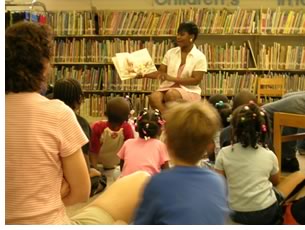 Unity through diversity
Unity through diversity
Holzman says that the project itself is the result of unity through diversity.
Programs that were once associated with two distinct cultural organizations
now reside in one comprehensive structure, yet are dispersed throughout
ImaginOn. The theatres are at opposite ends of the building, but are
connected through the library spaces and PLCMC’s attending programs.
By housing both youth-oriented organizations under one roof, they have
created an opportunity to engage children with stories in an entirely
new way. ImaginOn’s visitors can now experience the written,
spoken, and electronic word in a fully-integrated, self-directional,
interactive environment. “The nurturing of young people at every
stage of their development to allow them to discover their individual
potential and to challenge their intellect is at the heart of ImaginOn,” says
Holzman. “The building is more than a setting for activity, it
is a story all its own, captivating the minds and imagination of young
people and families.”
Copyright 2005 The American Institute of Architects.
All rights reserved. Home Page ![]()
![]()
 |
||
|
||